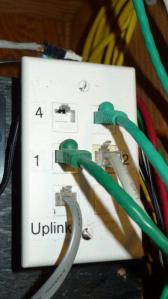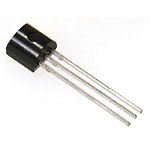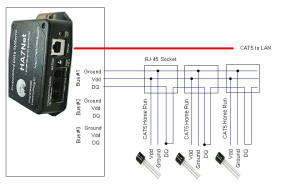i see bots
In the future, you won't think this is so weird
1-Wire
“1-Wire” is the name for a device bus protocol designed to be inexpensive, easy to connect, and easy to interface with.
The name “1-Wire” is a marketing take on the fact that data is conducted over a single wire. You still need a ground connection, but “2-Wire” presumably didn’t sound as interesting. In this configuration, devices on the bus operate in “parasitic” mode, storing power accumulated during bus transitions. In reality, I found it more reliable to operate in “3-Wire” mode, where you send some power along a third wire. The specification was originally introduced by Dallas Semiconductor, which was subsumed into Maxim via acquisition.
See Maxim’s list of devices and bus infrastructure. The DS18S20 temperature sensors I’m most familiar with look like your average transistor (image from here):
A given implementation of a 1-Wire bus, which Maxim refers to as a “microlan”, is composed of a bus controller or “master”, the physical wire segments of the network itself, and the “slave” 1-Wire devices attached to those segments. The bus controller can be: a dedicated hardware device, which connects to the 1-Wire bus on end and, say, an RS-232 port on the other, and implements the requisite bus protocol. Or, you can directly connect the bus to a PC’s serial port via a simple circuit, and work the bus in software on the PC.
In theory, any number of 1-Wire devices can be attached to a 1-Wire bus, since each device has a 64-bit unique identifier burned into it, which the controller/master uses to track the slave devices. However, there are important topological considerations to take into account, given the electrical characteristics of the wire segment of the network, which, due to impedence “weights”, can introduce signal reflections. Maxim covers these topics in a design note (here), to help explain which network topologies to avoid (such as “star” networks), and which ones to favor.
I started using 1-Wire nearly 10 years ago, because I found an inexpensive weather station from AAG based on 1-Wire devices. I mounted the weather station on the roof and ran a couple (ok, 3) wires down to the basement, which is where a Midon Design bus controller (at the time, “TEMP05”, but he’s up to “TEMP08” now!), connected via RS-232 to an always-on PC, was located. On the PC, I ran Homeseer: a script would pull ASCII weather data generated by the TEMP05 and log it, and I had other scripts to graph weather trends. The weather station used a 1-Wire temperature sensor for measuring outside temperature, and other 1-Wire devices to transmit wind speed and direction. That setup worked for quite a few years, until our Pacific Northwest weather did it in. I’ve since graduated to a David Instruments weather station - more on that later.
Along the way, I also hooked up a couple of DS18S20 temperature sensors, mostly out of curiousity, and it was through these experiments that I learned a bit about best practices - for my house, anyway - for implementing a reliable 1-Wire bus. I wanted to use, where possible, the existing CAT-5 home-run wiring I had installed in the house… but given that I had a single bus controller - the TEMP05 - I knew that a star configuration would not work. So I had to daisy-chain together the network segments, including the long run to the weather station on the roof. I found that this configuration didn’t work reliably under parasitic power, but fortunately, the TEMP05 device makes it easy to provide the +5V Vdd needed to power the microlan.
This helped, but it still wasn’t rock-solid reliable. In most cases, it didn’t matter, given that I could poll for temperature readings every minute or so and average the results. Adding reflection-dampening resisters (per Midon Design advice) helped some. But I didn’t like the idea that I had to custom-tune the network every time I changed or added devices. A more robust and easy-to-get-right solution seemed to require multiple controllers, perhaps one per physical network leg?
Along that line of thinking, I tried out a relatively inexpensive ($29) bus controller, the “CK0110” four-channel kit from Carl’s Electronics, which seemed to be able to support 4 microlans. That helped.
At some point, I stumbled upon Embedded Systems’ TCP/IP-based bus controller, the HA7Net, which does this: you connect up to three microlans to it, add power, and patch it into your LAN. It looks like this:
You can then point a browser at it and query the devices that it is managing on any of the three microlans. Furthermore, you can connect to it via a telnet session, which is how I integrated it into Homeseer (via the Ultra1Wire plugin, a newer version of which can be found here). I liked this approach because it meant one less RS-232 serial port to deal with (although this turns out to have been a temporary phenomena, given the approach I took to integrating with A/V receiver and monitor - see this post for the details).
The scenarios supported by these 1-Wire temperature sensors had expanded at this point to include:
- Turn on bathroom fans if someone is taking a shower, run for 10 minutes after shower ends (this one took a while to pull off, but now it seems perfectly commonplace)
- Turn on Kitchen fan if high temperature detected over the stovetop
- If temperature in computer rack gets too high, warn
(See this list for a complete list of implemented and planned scenarios)
Those scenarios required 5 or 6 sensors, which means that, with the HA7Net’s support for only three microlans, I would have to daisy-chain a few of the sensors, all of which were hanging off the far ends of CAT-5 homeruns, in the various corners of the house. The approach I took was to wire up a daisy-chain junction box, located in the basement. Here’s a photo:
 At each device, one conductor brings the DQ signal line “in” to the device, and another conductor takes it “out” to the next device down the line. All devices are wired to the same power and ground conductors. The junction box down in the basement contains RJ-45 sockets into which patch cables, each one representing a device, are plugged in. One end of the chain goes to the HA7Net.
At each device, one conductor brings the DQ signal line “in” to the device, and another conductor takes it “out” to the next device down the line. All devices are wired to the same power and ground conductors. The junction box down in the basement contains RJ-45 sockets into which patch cables, each one representing a device, are plugged in. One end of the chain goes to the HA7Net.
The “Uplink” cable connects to the HA7Net. The patch cables connected to sockets labeled “1”, “2”, and “3” connect to various 1-Wire temperature sensors, via the house patch panel.
Here’s a schematic:
This is the setup I’m using today. It’s reliable and easy to work with, and the availability of a well-built Homeseer plugin (the Ultra1Wire mentioned above) makes system integration very easy.
If I were starting over now, I would probably end up with a similar arrangement, despite the proliferation of cheap TCP/IP-enabled hacker boards. It’s hard to beat the <$5 price for a sensor-cum-network adapter. And the HA7Net bus master, while not cheap, is reasonably priced given that it’s TCP/IP-enabled and, since it supports three microlans, effectively means that you’d only need one in your house. (You could also substitute an Ardruino, using the 1-Wire library). If I were to try to build a network of temperature sensors that, for instance, is based on TCP/IP instead of 1-Wire, the per-device price would be much higher - for instance, the Arduino ethernet shield goes for $39-$45.
This would be a good point to make a general point about the world of devices or the so-called “Internet of Things” (see overview post)… while TCP/IP will be the dominant protocol at the high-level, since that’s how our top-level controlling computers are connected, down at the leaf nodes, where cost and size factors are important, alternate special-purpose protocols, such as 1-Wire, will be in abundance. Other examples include: the ZigBee wireless protocol, with low-power boards starting at $23, Bluetooth for $45, and the “Nordic” nRF24L01+ series, starting at $34… while some of these prices approach that of, say, the TCP/IP-based WiFi protocol, their physical size and complexity is much less so in comparison.
Even as the cost of TCP/IP-enabling devices drops in price, the lower-boundaries (size, cost) will also continue to drop. I think the thing to focus on is that 1-Wire devices are addressable, given their unique IDs, and ability to connect to a bus that can be bridged (via devices like the HA7Net) to the TCP/IP and therefore the Internet. Thus: not every connected device in the world will have a TCP/IP address, but you’ll still be able to talk to it, learn its state, and issue commands to it. That’s OK, I think.
NOTES
- Carl’s Electronics offers an inexpensive RS-232-based 4-port 1-Wire bus controller kit.
- Quozl (http://quozl.us.netrek.org) is an interesting fellow and offers an interesting site, describing a number of open source projects and hacks. He supplied the code for abovementioned 4-port 1-Wire bus master.
- Arduino support for 1-Wire: background and library: http://www.arduino.cc/playground/Learning/OneWire
- More background on 1-Wire, including links to software for directly driving the 1-Wire bus from a PC: http://www.arunet.co.uk/tkboyd/e1didx.htm.
- Hobby Boards (http://www.hobby-boards.com/catalog/index.php) offers a range of 1-Wire devices and kits, including: temperature, humidity, relays, displays.
- I used - for the first time - “TinyCAD“, an excellent free schematic drawing tool, to draw the 1-Wire schematic above. I found it very easy to use.


